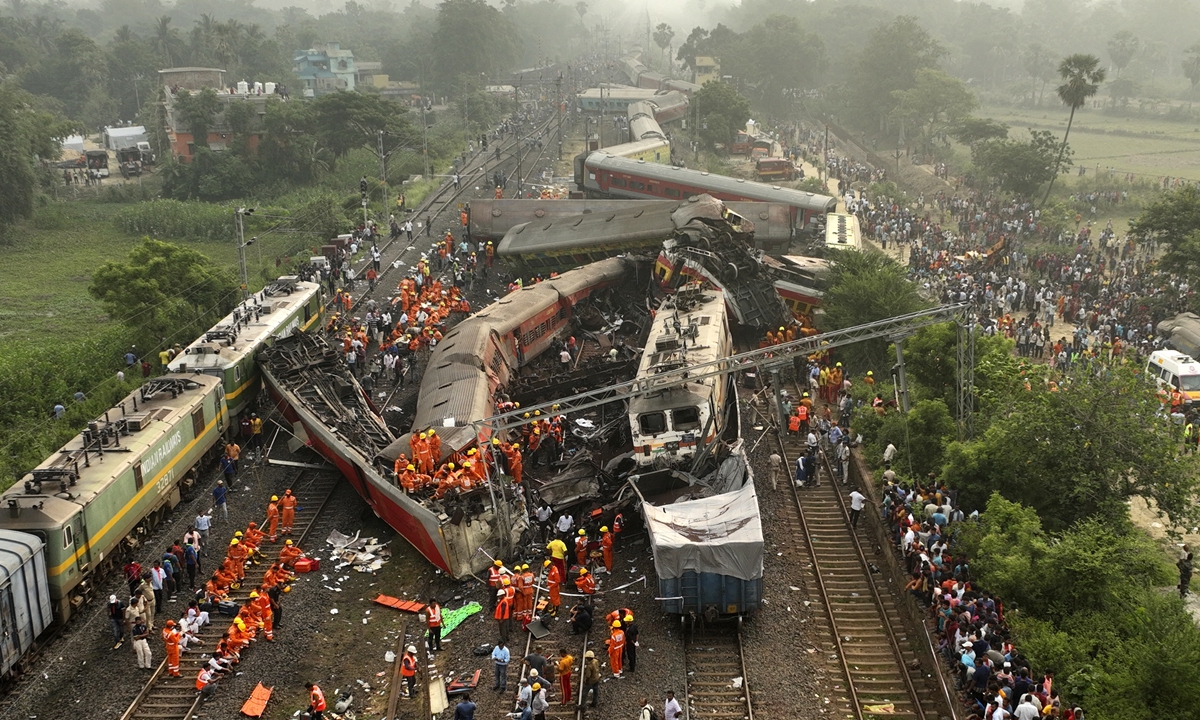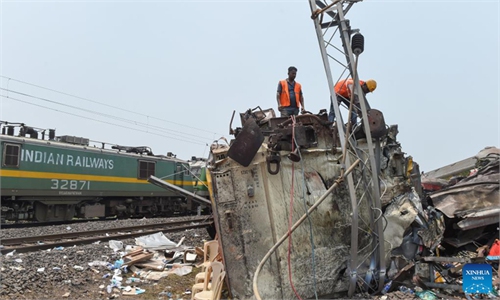'Signal interference' causes deadliest train tragedy in India
Rail ministry should improve management, reduce human error: experts

A drone shot of rescuers work at the site of passenger trains accident, in Balasore district, in the eastern Indian state of Orissa, Saturday, June 3, 2023. Hundreds of others were trapped inside more than a dozen mangled rail cars, in one of the country's deadliest train crashes in decades. Photo: VCG
Signal interference has been determined as the likely cause of Friday's deadly train crashes in India, said the country's rail minister on Sunday. The death toll rose to 275 later on Sunday in India's deadliest rail accident in more than 20 years, according to Indian media outlets.
A total of 275 people lost their lives and over 1,000 were injured in one of the country's worst accidents, as reported by Indian media outlet Hindustan Times on Sunday.
According to officials, the Coromandel Express, which runs from Kolkata to Chennai, hit the derailed bogies of a few coaches of Yashwantpur-Howrah Express, which derailed and toppled onto the adjacent track. A freight train was also said to have been involved in the accident.
On Saturday, Indian Prime Minister Narendra Modi arrived at the accident site and also met with some of the injured in hospital, according to Hindustan Times. Modi said, "No one would be spared and strong action would be taken against those found guilty," the Hindustan Times reported.
India's Minister of Railways Ashwini Vaishnaw said on Sunday that the cause of the accident in the eastern Indian state of Odisha was due to changes made to the point machine and electronic interlocking system, according to the Xinhua News Agency. He also stated that the individuals accountable for the accident have been identified and that efforts to restore the railway line are currently under way.
The Global Times has learned from the Chinese Consulate General in Kolkata that no death or injuries of Chinese nationals have been reported from the accident as of Sunday afternoon.
Although India has invested heavily and made remarkable progress in the construction of transportation infrastructure in recent years, this major accident has exposed the huge gap that continues to trouble the country, experts noted.
The chaotic management and insufficient emergency response capability of the country's rail system are likely to be the main reasons for the accident, while its aging infrastructure could be an indirect cause, Liu Zongyi, secretary-general of the Research Center for China-South Asia Cooperation at the Shanghai Institutes for International Studies, was quoted by China Business Network as saying.
Qian Feng, director of the research department at the National Strategy Institute at Tsinghua University, pointed out on Sunday that India bears heavy historical debts in transportation infrastructure, which could lead to serious accidents.
India has one of the largest extensive rail networks in the world, most of which was built more than 160 years ago while under British colonial rule.
Qian noted that in recent years, especially after incumbent Prime Minister Narendra Modi took office, the Indian government has prioritized upgrading the populous country's transportation infrastructure. The Modi administration recently raised capital spending on improving transportation to $122 billion in the fiscal year, 1.7 percent of its GDP.
Data shows that India has made remarkable progress in rail safety in recent years. The country used to see an annual average of 475 derailment accidents from 1980 to 2002, but the number has been reduced to just over 50 per year from 2012 to 2021, according to a paper by India's railway officials presented at the World Congress on Disaster Management.
However, as India has a very large rail system, the current investments and efforts still seem insufficient to fundamentally fix situation in the country's transportation infrastructure, Liu said.
Despite the improvements in the country's transportation system, statistics show that more than 16,000 people were killed in nearly 18,000 railway accidents across the country in 2021, according to the country's National Crime Records Bureau (NCRB).
There is a large amount of historical debt that India to this day still bears in transportation infrastructure, which needs more time to be paid off, said Qian.
In particular, the internal management of the rail system requires improvement or reform, said Qian. The rail ministry should focus on improving the management level and the sense of responsibility of relevant officials to reduce accidents caused by human error.
Observers noted that compared to other major countries, India still lags behind in the overall level of infrastructure.
"Such safety hazards are a hindrance for India to become an economic power or potentially a superpower," said Qian. "The accident is likely to make the Indian government realize the urgent tasks that need to be done in terms of infrastructure development."

